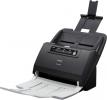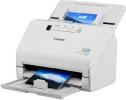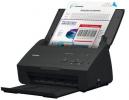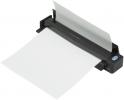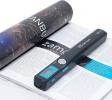Reviews related to : Scanners
While I have previously looked at many scanners, I think this is my first A3 scanner. I have looked at several A3 units that were ‘All In One’. So while any A3 unit is somewhat larger than an A4 unit this seems not to be that much larger. So if you have need to scan items of A3 size rather than using A4 and joining the two images together this is for you.
The measures 41x33x46cm with the input and output trays open; it is 41x23x11cm with them closed. The power input and the USB connection – lead provided - are side by side back left corner, the controls on the unit are on the right side of the top in a vertical line. The exception is a slider on the front edge when you choose U-turn or Straight as the image path.
While these days the vast majority of images are taken on peoples phones it’s not that many years ago that they were taken on cameras and only a little longer ago they were taken on film with a negative that gave a printed image. So there are still a great number of irreplaceable images that exist only as a printed photograph and each time they are taken from an album the chance of damage happening is increased so get an image now while you still can.
The Canon imageFORMULA RS40 Photo and Document Scanner measures 31cm wide, 17cm from front to back although this increases to 36cm when the receiving tray is extended and 26cm tall. There are folded sheets with Getting Started instructions in several languages. Basically remove the tape and one orange plastic shield.
Over the years I have reviewed a lot of scanners, all previous units required installation not so here, just open the box plug the USB lead into your PC or Notebook, plug the other end into the rear of the unit. Open the lid that forms part of input tray add a sheet of paper and press the button. You now have a .PDF copy of that sheet of paper on your Desktop.
The Canon Portable Scanner ImageFormula R10 measures 28x9.5x4cm when closed; add another 10cm to the depth and 8cm to the height when open. The weight is something that with Desktop items I normally do not give but here as its portable I will, it is just on a kilo. The outside of the unit has the mini USB connector on the rear with a Kensington Lock Port to its right. Flip open the lid and towards the right is the start button that is it, there are no more controls.
Do you know where you are going or what you are planning to do? I only ask because somebody else might be privy to this information.
For some reason whenever I hear of, or come across the term, "Stalkerware", my thoughts immediately turn to the victim being a celebrity who is the target for this type of malware. But as recent research into this anti-social phenomena has shown, this is not always the case. The perpetrator of this type of attack is not just interested in celebrities but also ordinary members of the public in their attempts to gather the information they need to carry out their nefarious activities.
While the scanning element of a multifunction device works fine for many tasks. Sometimes you need the greater functionality provided by s standalone product.
Generally when flatbed scanners come my way, they form part of a multifunction device operating in partnership with an inkjet or laser printer. But there are still some standalone A4 flatbed scanners for those who prefer separate units. One such product is the HP ScanJet 2500F1 model that is currently taking up space on my work top. Before concentrating on this flatbed scanner I would like to comment on the packaging in which the unit arrived.
At the start of December I told you about a portable page scanner from IRIS and mentioned there were other such devices that could read information from a book or magazine without the need for it to be torn out. Here is such a device.
The IRISPen Air 7 is truly portable and it is used like a pen with you scanning a line at a time, it is a bit like highlighting a line or so of text from a page to help to remember a fact or statement. With the highlighter method you still need to refer back to the book to get that fact when you revise, not so here as you scan into your PC or portable device and the book remains in pristine condition. It is 13.5cm long 2.5cm wide and 1.
For a very long time people have talked about a paperless office, and yes we all still seem to be drowning in paper. Utility companies and banks want you to go paperless but there is not normally a great incentive to do so.
Here a small scanner that may assist as it lets you scan and then convert files into a format readable by Word and Excel to name but two. It comes in a small box and the scanner itself is 28.5x5x3cm there are minimal instructions consisting of a single sheet with just four points. So no CD is supplied and if you are on dial up or a very slow connection this is not for you as when downloaded and installed the hard disk space taken is over 3GB.
While standalone flatbed and All-in-One devices can cope with many scanning tasks, sometimes you need a more specialised piece of equipment to handle this aspect of your document management needs.
The Brother DS-920DW is a device described as an “anywhere, anytime, portable scanner”. As the “DW” part of the product’s model number might indicate, this scanner offers both Duplex or double sided scanning and wireless connectivity.
When a Brother product arrives for review, usually its main function is that of a printer whether of the monochrome or colour variety. However printers are not the only type of device that is associated with Brother. The company also manufactures scanners either as a standalone unit or combines with a printer to make a multifunction device. In the former category is the Brother ADS-2100e which has been developed for use in a medium sized office environment. This scanner requires a USB connection to the computer system.
Predominately black in colour, the ADS-2100e is a wedged-shape unit. In its closed state it has dimensions of 299 x 220 x 179mm (W x D x H) and weighs 3.3kg. Raising the top cover of the unit increases the scanner’s height measurement to 305mm and reveals the paper feeding mechanism and the basic control options available with the AD-2100e.
While London has its Gherkin, Brussels has its Egg which was the location for the annual IRISLink event where a new portable scanner was launched.
As part of the Canon family, IRIS concentrates its expertise on the development of OCR (Optical Character Recognition) software, scanning devices and related business services. A recent additional to the company’s various products is IRIScan Pro 3 Wifi which offers to “Scan anywhere, share anytime” This product is based around a portable document scanner.
The IRIScan Book is a portable, cordless, battery-powered scanner. Hence, it is easy to take it to the material to be scanned rather than vice versa and so one can capture material wherever you are.
Black in colour, 220mm long, and with a 25 x 30mm rectangular cross section it weighs roughly 220g including four AAA batteries and is such a size and weight that it will easily slip in one’s laptop bag. It is supplied with ordinary alkaline batteries and, although it can be used with NiMH rechargeables, IRIS does not recommend it. This is because the latter operate at 1.2V per cell rather than 1.5V and so will provide a shorter usage life.
I admit that the main reason I accepted this evening invitation was to see the view from the top of The Shard, sadly the 34th floor was the highest we got but this amazing portable scanner made up for the disappointment initially felt.
A scanner to turn documents the right way up automatically – however you feed them - certainly got this journalists attention. Being cordless is another box ticked, having the ability to transmit data to mobile devices is another and being small enough to fit in any bag cannot be a minus. Setup took around 10 minutes while 2.4GB of data was transferred from the supplied DVD to my PC via USB.
From its Belgium base, as part of its Document to Knowledge mantra, IRIS has released the latest version of its IRISPen product. This is the IRISPen Executive 7 offering which boasts You scan, it types as it performs its designed role of a hand-held scanner.
While the product’s title refers to the scanner element of this package as a “pen”, it is more like a black magic marker or highlighter in appearance right down to the removable cap at one end. It is this end that contains the scanner element which is protected by the cap when not being used. This “pen” unit has dimensions of 15 x 140 x 25mm (H x L x W) with a mini USB port at the opposite end to the cap.
Many years ago my first scanner was a handheld device, shaped a bit like a paintbrush, with a scanning width of about 4-inches. A more modern version increases the scanning width and adds Wi-Fi capability.
When checking on a new piece of hardware, one of the first things I do is to peruse the Quick Start Guide. Unfortunately this was not immediately possible with the IRIScan Book Executive 3 product. While there was documentation regarding other IRIS products, registration and a slip of paper that explained, in several languages, that the Quick Start Guide was on the supplied CD in PDF format.
Even with Bluetooth allowing personal data to be transmitted over the airwaves between devices, business cards continue to be the main method used by many when supplying others with their personal details. The problem then exists of what to do with this information apart, of course, from forgetting about it and leaving the cards in your pocket thus increasing the risk that they could become mixed up with your own cards. Rather than take the time and effort to type in the information into a contact database yourself, you could let technology take the strain by using a dedicated business card scanner.
Recently arrived from that hotbed of Belgium scanning technology is the IRISCard Anywhere 5 product. Released under the tag line of You scan, it organises, this product consists of a portable, cordless card scanner and contact management software for either the Windows or Mac platform.
Although an ordinary flat-bed scanner handles individual documents and photos without any difficulty, there are problems when one needs to scan pages in a book or any other bound material. This is because the spine prevents the pages being held flat on the scanners platen and so you get a very distorted portion of the image. With its OpticBook 3800, Plustek has produced an effective solution to this problem in a machine which does not take up too much desk space and is ideal for the serious student, library or SoHo worker.
It is black and silver in colour and is roughly 11 x 18 x 4inches high. With its large Cancel, Colour, Grayscale and B&W buttons it has a business-like appearance. Unlike normal flat-bed scanners, where the edge of the glass platen is an inch or more from the edge of the machine, this is very much reduced in the OptiBook where the platen, together with the scanner head, extends to within about 0.25 inch of the edge of the machine.
Where once it was enough for a device to satisfy discerning users by performing a single function, now devices need to be multi-functional in order to loosen customers purse strings and make a sale.
When is a mouse not a mouse? The answer to this riddle could well be when it is a new classification of product that owes its concept to an innovative Belgium company. This company is I.R.I.S. and the product in question is its IRIScan Mouse which, as its title indicates, combines the features of a pointing device with a hand-held scanner. The IRIScan Mouse comes with the tag line of “You swipe, it scans.
Unlike my usual desktop flatbed scanner, which copies single-sided documents, this next scanner can copy both sides of a document simultaneously.
The Brother DS-700D was almost one of those chicken and egg situations when I opened the packaging encasing a new scanner from Brother. There was no Set-up or Quick Start Guide in the box. Should the hardware be connected before or after the software, I asked myself? Fortunately on examining the supplied USB cable, I noticed it had a sticker on one end that advised me that the software installation should come first.
Having recently looked at a small printer this is even smaller than that. However this is designed to scan pictures and or read items on SD cards. So unlike the aforementioned printer this is not designed to scan an A4 page.
The Pandigital Photolink scanner measures 15.5x8.5x4cm and weights only 200grams. Perhaps you should forget the way a standard scanner works as this is designed to work standalone meaning you insert a photograph in the unit and it scans the image to a card in the built in SD card slot. Once the LED on the unit stops flashing (a few seconds) you can then scan another photograph and then another for as long as you have photographs to scan or to the capacity of the SD card.
While many users will be content with the scanner module that forms part of an All-in-One device, better quality can be achieved with a standalone model.
Adding to its range of standalone flatbed scanners, Canon has released its CanoScan LiDE 200 model. This colour image 48-bit scanner offers a resolution of 4800 x 4800 dpi that can be expanded to 19200 dpi through the use of software as part of a feature set designed to tempt those users wanting better quality than is usually available from the scanner unit forming part of a multi-function or All-in-One device. Opening the box reveals four components.

